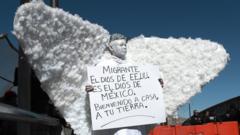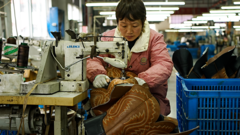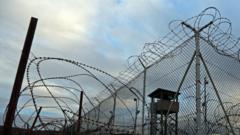**Amid escalating tensions regarding migration, Ciudad Juarez prepares a tent city to handle the increasing number of deportees as a consequence of recent US immigration policies.**
**Tent City Rises in Ciudad Juarez to Accommodate Incoming Deportees from the US**

**Tent City Rises in Ciudad Juarez to Accommodate Incoming Deportees from the US**
**As thousands of deportees are anticipated, Mexico mobilizes resources to support returning citizens.**
In the border city of Ciudad Juarez, Mexican workers are rapidly constructing a tent city to provide shelter for thousands of Mexicans expected to be deported from the United States. Located at the old fairgrounds, the site previously served as an altar for a mass by Pope Francis in 2016, now repurposed by the Mexican government in anticipation of what is being termed "the largest deportation in American history."
Construction crews are seen erecting a vast metal structure that will hold durable white tarpaulin, transforming the area into a temporary living space for deportees. The Mexican government has prepared for this anticipated influx along eight border locations, recognizing that an estimated five million undocumented Mexicans currently live in the US.
Mexican Interior Minister Rosa Icela Rodriguez pledged that the Mexican government would ensure deportees are cared for upon their return, providing basic amenities such as food, medical care, and assistance in obtaining identification documents. This initiative is part of a program called “Mexico Embraces You” to support repatriated citizens.
As the situation escalates, new President Claudia Sheinbaum has stressed the importance of humanitarian efforts, assuring deportees will have access to social programs, pensions, and the ability to work immediately upon arrival. She encouraged the Mexican public to maintain a composed attitude regarding relations with the US and its immigration policies.
President Sheinbaum’s administration is acutely aware of the potential strain that mass deportations could place on cities like Juarez and Tijuana, which are already inundated with migrants fleeing violence. Concerns about facilities like Juventud 2000 migrant shelter in Tijuana highlight the limited capacity to accommodate a sudden increase in people in need. Director Jose Maria Garcia Lara expressed anxiety regarding the potential overcrowding and resource shortages that may arise.
Moreover, President Trump’s recent executive orders include a controversial "Remain in Mexico" policy, which would require asylum seekers to wait in Mexico while their cases are processed. This plan faces resistance from the Sheinbaum government, which has made it clear that it will not accept non-Mexican asylum seekers under these conditions, indicating Mexico’s unwillingness to compromise its stance.
As preparations intensify on both sides of the border, with Mexican military assistance coordinating logistics in Tijuana and Juarez, it remains to be seen how the return of deportees will unfold. Tijuana has established an events center with 1,800 beds for returnees and is mobilizing resources for necessary supplies.
In a striking display of the looming reality, a minibus recently transported the first deportees back to Mexico amidst the backdrop of legislative changes in the US, symbolizing what many fear will be just the beginning of a much larger wave. With close to five million undocumented Mexicans facing uncertainty, the coming days promise to challenge the limits of support structures in Mexico, as the nation braces for an influx of citizens returning, many for the first time since childhood.
Construction crews are seen erecting a vast metal structure that will hold durable white tarpaulin, transforming the area into a temporary living space for deportees. The Mexican government has prepared for this anticipated influx along eight border locations, recognizing that an estimated five million undocumented Mexicans currently live in the US.
Mexican Interior Minister Rosa Icela Rodriguez pledged that the Mexican government would ensure deportees are cared for upon their return, providing basic amenities such as food, medical care, and assistance in obtaining identification documents. This initiative is part of a program called “Mexico Embraces You” to support repatriated citizens.
As the situation escalates, new President Claudia Sheinbaum has stressed the importance of humanitarian efforts, assuring deportees will have access to social programs, pensions, and the ability to work immediately upon arrival. She encouraged the Mexican public to maintain a composed attitude regarding relations with the US and its immigration policies.
President Sheinbaum’s administration is acutely aware of the potential strain that mass deportations could place on cities like Juarez and Tijuana, which are already inundated with migrants fleeing violence. Concerns about facilities like Juventud 2000 migrant shelter in Tijuana highlight the limited capacity to accommodate a sudden increase in people in need. Director Jose Maria Garcia Lara expressed anxiety regarding the potential overcrowding and resource shortages that may arise.
Moreover, President Trump’s recent executive orders include a controversial "Remain in Mexico" policy, which would require asylum seekers to wait in Mexico while their cases are processed. This plan faces resistance from the Sheinbaum government, which has made it clear that it will not accept non-Mexican asylum seekers under these conditions, indicating Mexico’s unwillingness to compromise its stance.
As preparations intensify on both sides of the border, with Mexican military assistance coordinating logistics in Tijuana and Juarez, it remains to be seen how the return of deportees will unfold. Tijuana has established an events center with 1,800 beds for returnees and is mobilizing resources for necessary supplies.
In a striking display of the looming reality, a minibus recently transported the first deportees back to Mexico amidst the backdrop of legislative changes in the US, symbolizing what many fear will be just the beginning of a much larger wave. With close to five million undocumented Mexicans facing uncertainty, the coming days promise to challenge the limits of support structures in Mexico, as the nation braces for an influx of citizens returning, many for the first time since childhood.























